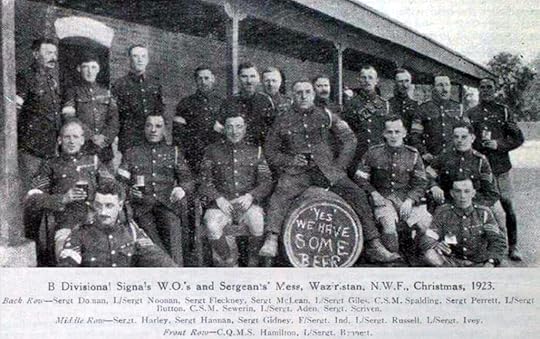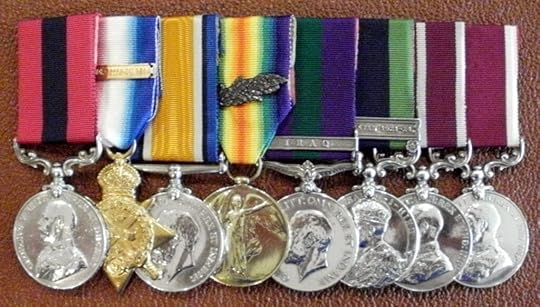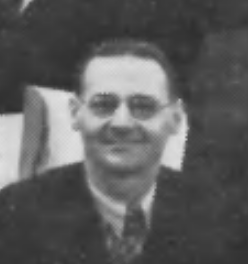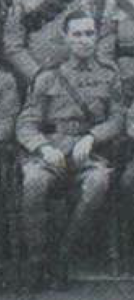‘Who are they? Where are they now?’
This article was written as a contribution to The Wire, the Royal Signals in-house magazine, in 2018. It is reproduced here in its original (somewhat fuller) format and with some minor additions and corrections made possible by information received since publication.
[image error]‘Where are they now?’ The Wire June 1959
The photograph above appeared in The Wire in June 1959 under the heading ‘Who are they? Where are they now?’
The accompanying caption was:
Taken outside the W.O’s and Sergeants Mess S.T.C. (I), Jubblepore, India, 1931?
Reading from left to right, (Standing): C.S.M. H Hartley, D.C.M., M.S.M., CQMS Andrews, M.S.M.
(Seated): RQMS Nixon, RQMS Earwaker, M.S.M., RSM May, D.C.M., M.S.M., RQMS Sewerin, M.S.M.
When the photo was taken: Total Service 133½ years. Total Indian Service 116½ years. Average Service 22 years. Average Service in India 19½ years. Total Medals, 38. Average 6½.
The photo was, indeed, taken at the Warrant Officers’ and Serjeants’ Mess at the Signal Training Centre (India) at Jubbulpore but it was taken earlier than suggested, probably in 1929 before some of those listed returned to the United Kingdom at the end of their service. So, to answer the original question:
Standing, left to right:
6454569 Warrant Officer Class II (Company Serjeant Major) Henry Edward Harley DCM
Henry Edward ‘Harry’ Harley (not Hartley as recorded on the caption) was born on 4 January 1886 at Finsbury Park, Middlesex. A pre-war regular soldier, he had enlisted firstly into the militia, joining 7th (Militia) Battalion, Royal Fusiliers (City of London Regiment) in October 1907, before enlisting into the Regular Army on 13 February 1908. His older brother, William, also enlisted into the regiment—he was killed in action during the German offensive on 27 March 1918. Harley joined the 4th Battalion in Ireland and in February 1909 was posted to the 3rd Battalion in South Africa. He served with the battalion in Mauritius from the end of that year until 1911 when it joined the garrison in India. Just prior to the outbreak of war, in July 1914 he was posted for duty with the Indian Signal Service.
Harley joined 35th Divisional Signal Company, which formed the basis of 7th (Meerut) Divisional Signals and with which he served in France from October 1914 and in Mesopotamia from January 1916; by May 1917 he had been promoted to corporal. The division was sent to Egypt at the end of that year and in April 1918 became part of Allenby’s Egyptian Expeditionary Force in Palestine. After minor operations in the Judean Hills in June, in August 1918 in a purely administrative move Harley was transferred to the Leicestershire Regiment (renumbered 48558), and in September 1918 the division took part in the Battle of Megiddo. For his conduct at Megiddo with the divisional signals Harley earned a Mention in Despatches[1] and was awarded the Meritorious Service Medal for valuable services.[2] After the war he remained in the Middle East with the occupation forces before a period of leave in the United Kingdom in the first half of 1920, after which he returned to India and joined 33rd Divisional Signal Company. In addition to the 1914 Star with clasp ‘5TH AUG.–22ND NOV. 1914’, British War Medal 1914-20 and Victory Medal, for his service in Iraq he was awarded the General Service Medal 1918-62 with clasp ‘IRAQ’.
He transferred back to The Royal Fusiliers (City of London Regiment) after the war (renumbered GS/135938) but continued to serve with the Indian Signal Corps in 33rd Divisional Signal Company, The company was renamed ‘B’ Divisional Signals in November 1920 and Royal Signals became responsible for the British officers and other ranks in the Indian Signals Corps.[3] In this period he was renumbered 6454569 and held on the Indian Unattached List (numbered 1508).
‘B’ Divisional Signals rook part in the Waziristan Campaign of the early 1920s, for which Harley was awarded the Indian General Service Medal 1908-35 with clasp ‘WAZIRISTAN 1921-24’. In addition, importantly he earned the first first Distinguished Conduct Medal after the formation of Royal Signals for his conduct on 4 February 1923.[4]

Serjeant’s Mess, ‘B’ Divisional Signals, Waziristan, 1923.
Company Serjeant Major Sewerin is in the back row, third from right. Serjeant Harley is in the second row sitting on the far left.
From Honours, Decorations, and Medals to The Royal Corps of Signals for Gallantry & Distinguished Service, 1920-2020:
‘Harley was serving with the advance guard of 9th Indian Infantry Brigade on 4 February as it advanced to Tauda China to link up with 7th Indian Infantry Brigade. The fighting was severe during the occupation of the village and in the establishment of piquets later in the evening, with 30 casualties being suffered—one of the wounded was Harley. Later Major Pollard[5] wrote:
‘Harley when wounded asked for me. I came up on my pony and we all thought that he was a goner as the bullet appeared to have entered his stomach in front and there was an exit hole at the back. But somehow the bullet had gone round under the skin and had not pierced the bowels. Still the journey back from Tauda China in a camel kajawah was enough to kill a fit man.’[6]
In June 1926 he was promoted to company quartermaster serjeant and at the end of the year he was awarded the Long Service and Good Conduct Medal. His unit was the retitled again, becoming 2nd Indian Divisional Signals. Harley transferred to the Royal Signals Special Roster (India) in 1927 and in 1929 joined the Signal Training Centre at Jubbulpore as a company serjeant major. He sailed from India aboard RMS Viceroy of India that December and was discharged at the end of his service on 4 January 1930. Harley returned to London where he married and became a porter at a block of flats. He died at Wood Green in 1957, aged 71.[7]

The medals group of Warrant Officer Class II (Company Serjeant Major) Henry Edward Harley DCM
5662970 Company Quartermaster Serjeant Harold Albert Andrews
Harold Albert Andrews enlisted into Prince Albert’s (Somersetshire Light Infantry) in 1907 (8196 Private) and joined the 2nd Battalion in India. Attached to the Indian Signals Service, during the First World War he served with 14th Indian Divisional Signal Company in Mesopotamia from February 1915, where he was mentioned in despatches twice, firstly for the operations at Amara in May and June 1915,[8] and secondly in 1917.[9] He was renumbered 5662970 in 1920.
Having returned to India, he remained attached to the new Indian Signal Corps, serving with 38th Divisional Signal Company (later renamed) ‘F’ Divisional Signals. He was renumbered 5662970 in 1920 and held on the Indian Unattached List (numbered 1114). For his conduct during the Mahsud Campaign he earned the Meritorious Service Medal for valuable services.[10] In addition to the 1914-15 Star, British War Medal 1914-20 and Victory Medal, he was awarded the Indian General Service Medal 1908-35 with clasps ‘MAHSUD 1919-20’, ‘WAZIRISTAN 1919-21’, and ‘WAZIRISTAN 1921-24’. From the mid-1920s he served with No. 1 (Line) Company, ‘B’ Corps Signals prior to joining the Signal Training Centre (India) at Jubbulpore. He transferred to the Royal Signals Special Roster (India) in 1927. He was discharged on 11 December 1929.
Seated, left to right:
1852514 Warrant Officer Class II (Regimental Quartermaster Serjeant) Harry Nixon
Harry Nixon enlisted into the Corps of Royal Engineers in 1909 (18900 Sapper) and was posted to India where he was attached to the Indian Signal Service. He served in the Middle East from July 1915 and throughout the war with a divisional signal company. He returned to India after the war and served during the Third Anglo-Afghan War as a corporal with No. 3 Wireless Signal Squadron, with which he continued to serve after it became No. 2 (Wireless) Company, ‘A’ Corps Signals based in Karachi. He transferred to Royal Signals on its formation and was renumbered 1852514 in 1920. In addition to the 1914-15 Star, British War Medal 1914-20 and Victory Medal, he was awarded the Indian General Service Medal 1908-35 with clasp ‘AFGHANISTAN NWF 1919’.
He was promoted to serjeant in April 1922 and posted to the Signal Training Centre (India) at Jubbulpore in late 1925, and was promoted to Warrant Officer Class II (Company Serjeant Major) on 5 January 1930. He was discharged on 13 November 1930.
1851911 Warrant Officer Class II (Regimental Quartermaster Serjeant) Thomas Earwaker

Thomas Earwaker, Indian Signal Corps reunion, 1938
Thomas Earwaker was born on 23 January 1891 at Wanstead in Essex. He enlisted into the British Army as a boy in 1905 (14859 Sapper) and served with the Royal Engineers Signal Service in India in 35th Divisional Signals. On the outbreak of war, with Henry Harley he sailed for France with 7th (Meerut) Divisional Signal Company (the renamed 35th Divisional Signals); the company arrived in France on 7 October 1914. After the Battle of Loos, the division sailed for Mesopotamia and Earwaker was mentioned in despatches for his service there in early 1916[11] and in 1917 he was awarded the Meritorious Service Medal for valuable services as a staff sergeant.[12] He served with the company in its final actions in Palestine in 1918. Earwaker transferred to Royal Signals on it formation and was renumbered 1851911 in late 1920 and held on the Indian Unattached List (numbered 1118).
In addition to the 1914 Star with clasp ‘5TH AUG.–22ND NOV. 1914’, British War Medal 1914-20 and Victory Medal, he was awarded the Indian General Service Medal 1908-35 with clasp ‘WAZIRISTAN 1919-21’. The latter was earned a regimental quartermaster serjeant in charge of a ‘war expense store’ at Kalabagh supporting ‘B’ Corps Signals.
He was promoted to serjeant in April 1922 and served with ‘B’ Corps Signals at Rawalpindi as a mechanic quartermaster serjeant. By 1926 was serving there as a regimental quartermaster serjeant. In 1927, Earwaker joined the Signal Training Centre (India) at Jubbulpore, again as a regimental quartermaster serjeant. He was discharged on 16 April 1930 and he and his family settled in Slough in Buckinghamshire where he worked as an instrument repairer. He died in Wiltshire in 1978, aged 87.
1850479 Warrant Officer Class I (Regimental Serjeant Major) Harold Vincent May DCM, MM
Harold May was born in Alverstoke, Hampshire on 23 April 1889. He enlisted into the into the Corps of Royal Engineers in 1907 (16662 Sapper) and became a telegraph lineman. He went to France just after the outbreak of the First World War on 15 August 1914 as a serjeant and later he served with 63rd (Royal Naval) Divisional Signal Company, with which he earned the Military Medal[13] and the Distinguished Conduct Medal,[14] the latter for his conduct during the German offensive in March 1918. The citation stated:
He has done consistent good work while with this company. During the retreat in March, while the column was under shell fire, he kept the men together and steadied them, inspiring confidence in them by his utter disregard of danger. At Henin, while the column was being heavily bombed, he did splendid work extricating the wounded and getting them to a place of safety. It was entirely due to him that the cable sections were reorganised and sent forward at a critical moment for work on important communications, contributing largely to the success of the operations.
For his war service he was awarded the 1914 Star with clasp ‘5TH AUG.–22ND NOV. 1914’, British War Medal 1914-20 and Victory Medal. After the war, May transferred to Royal Signals on its formation and was posted to India. He was promoted to company quartermaster serjeant in March 1923 and later served as the regimental quartermaster serjeant of Waziristan District Signals. From 1927 he was the regimental serjeant major of 4th Indian Divisional Signals at Jubbulpore. He was discharged on 24 April 1930. On his return to England went to work as a telegraph linesman in Romford in Essex. In 1941 he was commissioned into the Pioneer Corps and was promoted to Major in October 1945. Major H. V. May DCM, MM died at Romford in 1963, aged 74.
3436818 Warrant Officer Class II (Regimental Quartermaster Serjeant) Herbert William Robert Sewerin

Serjeant Sewerin, Rawalpindi 1922
Herbert Sewerin was born in London on 5 June 1889 to a German father and English mother. He enlisted into the British Army in 1906 and joined The King’s (Liverpool) Regiment (9733 Private). Posted to the 2nd Battalion in India, he served there attached to the Indian Signal Service until posted with a divisional signal company to Mesopotamia during the First World War. He was mentioned in despatches for his service as a regimental quartermaster serjeant in Mespotamia[15] and also awarded the Meritorious Service Medal for valuable services.[16]
After he returned to India he transferred to The Lancashire Fusiliers on 15 January 1920 (renumbered 3436818 in late 1920) and held on the Indian Unattached List (numbered 1116). He transferred to the Royal Signals Special Roster (India) in 1927. In addition to the 1914-15 Star, British War Medal 1914-20 and Victory Medal, he was awarded the Indian General Service Medal 1908-35 with clasps ‘WAZIRISTAN 1919-21’ and ‘WAZIRISTAN 1921-24’, which he earned with No. 1 Signal Field Park and ‘B’ Divisional Signals respectively. His final posting was as a regimental quartermaster sergeant at the Signal Training Centre (India). Departing STC(I) with his family on 5 March 1930, he arrived in England on 28 March 1930 and was discharged the following day. He subsequently went to work as a solicitor’s commissaire in Chingford in Essex. Herbert Sewerin died in Essex on 26 May 1957, aged 67.
It can be seen that the medal tally of 38 referred to in the original caption amounts to two Distinguished Conduct Medals, one Military Medal, four Meritorious Service medals for valuable services in action, twenty-five campaign medals and six awards of the Army Long Service & Good Conduct Medal. In addition there were no fewer than five Mentions in Despatches.
I think that thoroughly answers the question posed in 1959!
1. (Back) London Gazette (LG) June 1919; 31383, p. 7179.
2. (Back) LG 12 December 1919; 31684, p. 15443.
3. (Back) The Army in India was reorganised after the First World War and in April 1920 the Indian Signal Corps was formed from the Indian Signal Service. Indian other ranks were transferred (or later enlisted) into the new corps but until 1927 the provision of British officers and other ranks was more complicated. Officer posts were filled by Royal Signals and, commonly, by seconded officers from other regiments. As time went by, the latter either transferred to Royal Signals or returned to their parent regiment, in much the same way for officers seconded to Royal Signals in the same period. British other ranks (no more than one-third of the unit establishments) came from Royal Signals or were attached regimental signallers; all were held on the Indian Unattached List. Until 1927, when Royal Signals assumed responsibility for the provision of all British other ranks, some attached signallers transferred to Royal Signals, some remained ‘attached’, and others returned to their parent regiment. In that year all attached other ranks were transferred to the Royal Signals Special Roster (India). For more see Metcalfe, N. P. (2021). Honours, Decorations, and Medals to The Royal Corps of Signals for Gallantry & Distinguished Service, 1920-2020. Blandford: Royal Signals Institution. p. xi.
4. (Back) LG 30 May 1924; 32940, p. 4305.
5. (Back) Major G. L. G. Pollard, Commandant, ‘B’ Divisional Signals.
6. (Back) Baretto, T. (1975). History of the Corps of Signals. Volume I, Second Edition, 2006. New Delhi: The Corps of Signals Association. p. 226.
7. (Back) Honours, Decorations, and Medals to The Royal Corps of Signals incorrectly records his age as 79.
8. (Back) LG 5 April 1916; 29536, p. 3665.
9. (Back) LG 15 August 1917; 30233, p. 8338.
10. (Back) LG 14 May 1920; 31899, p. 5476.
11. (Back) LG 17 October 1916; 29789, p. 10053.
12. (Back) LG 14 August 1917; 30234, p. 8431.
13. (Back) LG 3 June 1916; 29608, p. 5594.
14. (Back) LG 31 December 1918; 31092, p. 42. Citation: LG 2 September 1919; 31534, p. 11140.
15. (Back) LG 5 June 1919; 31386, p. 7243.
16. (Back) LG 22 September 1919; 31562, p. 11775.



